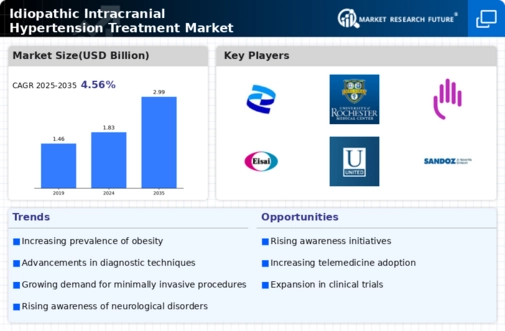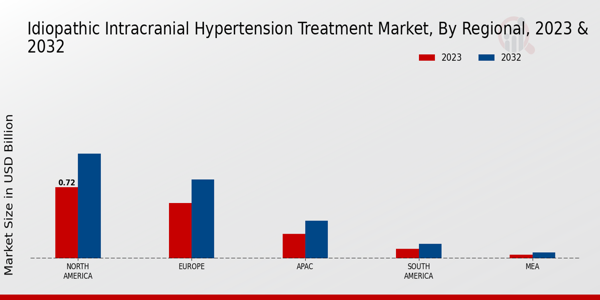Market Growth Projections
The Global Idiopathic Intracranial Hypertension Treatment Market Industry is projected to experience substantial growth over the coming years. With an estimated market value of 1.83 USD Billion in 2024, the industry is expected to reach approximately 2.99 USD Billion by 2035. This growth trajectory indicates a compound annual growth rate (CAGR) of 4.57% from 2025 to 2035. The increasing prevalence of idiopathic intracranial hypertension, coupled with advancements in treatment modalities and heightened awareness, suggests a robust market outlook. These projections highlight the potential for ongoing investment and innovation within the industry, ultimately benefiting patients and healthcare providers alike.
Increased Research Funding
The allocation of increased research funding towards idiopathic intracranial hypertension is a crucial driver for the Global Idiopathic Intracranial Hypertension Treatment Market Industry. Government and private organizations are recognizing the need for more effective treatments and better understanding of IIH. This influx of funding supports clinical trials and research initiatives aimed at discovering novel therapies. As research progresses, it is anticipated that new treatment options will emerge, enhancing the overall market landscape. The commitment to advancing IIH research is likely to contribute to the market's growth, particularly as new findings translate into clinical practice.
Growing Awareness and Education
The growing awareness and education surrounding idiopathic intracranial hypertension are vital for the Global Idiopathic Intracranial Hypertension Treatment Market Industry. Increased public and professional knowledge about IIH leads to earlier diagnosis and treatment, which can significantly improve patient outcomes. Educational campaigns and resources provided by healthcare organizations are instrumental in disseminating information about the condition. As awareness continues to rise, more individuals are likely to seek medical attention, thereby driving demand for treatments. This trend is expected to support the market's growth trajectory, particularly as the healthcare community becomes more adept at recognizing and managing IIH.
Advancements in Treatment Modalities
Innovations in treatment modalities for idiopathic intracranial hypertension are propelling the Global Idiopathic Intracranial Hypertension Treatment Market Industry forward. New pharmacological agents and surgical techniques are emerging, enhancing patient outcomes. For instance, the introduction of minimally invasive procedures has improved the management of IIH, leading to increased patient satisfaction. As these advancements become more widely adopted, the market is likely to experience significant growth. The projected compound annual growth rate (CAGR) of 4.57% from 2025 to 2035 underscores the potential for ongoing development in treatment options, which may further stimulate market expansion.
Market Dynamics and Competitive Landscape
The dynamics of the Global Idiopathic Intracranial Hypertension Treatment Market Industry are influenced by the competitive landscape among pharmaceutical and biotechnology companies. As companies strive to develop innovative therapies, the market is becoming increasingly competitive. This competition fosters a climate of rapid advancement in treatment options, which may lead to improved patient care. The anticipated market value of 2.99 USD Billion by 2035 reflects the potential for growth driven by these competitive forces. Companies that successfully navigate this landscape and bring effective treatments to market are likely to capture significant market share, further propelling industry expansion.
Rising Prevalence of Idiopathic Intracranial Hypertension
The increasing incidence of idiopathic intracranial hypertension (IIH) is a primary driver of the Global Idiopathic Intracranial Hypertension Treatment Market Industry. Factors such as obesity, which is a significant risk factor for IIH, have led to a rise in cases. In 2024, the market is valued at approximately 1.83 USD Billion, reflecting the growing need for effective treatment options. As awareness of IIH expands, healthcare providers are more likely to diagnose and treat this condition, thereby contributing to market growth. The demand for specialized therapies and interventions is expected to rise, indicating a robust market trajectory.


























Leave a Comment